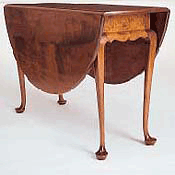ANSWER: I get almost as many questions about souvenir items from the 1939 New York World’s Fair as there were items sold or given away at the Fair. Well, not really, but pretty many.
 The item this person mentions–a small cast-iron Greyhound Bus tram–was one of over 25,000 different mementos made for the Fair. Fifty stands sold souvenirs–everything from postcards to guidebooks to view folders and books, as well as a myriad of novelties that gave "knick-knacks" a whole new meaning. Vendors also sold a myriad of pins. Orange and blue World’s Fair emblems graced the surfaces of every one of them.
The item this person mentions–a small cast-iron Greyhound Bus tram–was one of over 25,000 different mementos made for the Fair. Fifty stands sold souvenirs–everything from postcards to guidebooks to view folders and books, as well as a myriad of novelties that gave "knick-knacks" a whole new meaning. Vendors also sold a myriad of pins. Orange and blue World’s Fair emblems graced the surfaces of every one of them.The Fair opened on April 30 , 1939–the 150th anniversary of George Washington’s inauguration at Federal Hall in New York City. At 10:00 A.M. Mayor LaGuardia cut the ribbon at a dedication ceremony in the Temple of Religion. Trumpets heralded the procession of thousands of police officers and military men and public officials. And at 2:00 P.M. President Roosevelt dedicated the fair. Altogether, 60 nations and international organizations took part. Thirty-three states of the United States also had exhibits–and every one of them had giveaways and more deluxe souvenirs for sale.
Why is it then that the New York World’s Fair’s souvenirs seem to stand out from the Pacific Exposition in San Francisco that same year and the Century of Progress Exposition in Chicago six years earlier? For one thing, the shear numbers of items–millions of them–flooded the U.S. and the world with mementos of the Fair. Every visitor, no matter their economic status, brought home something, from small toys like the Greyhound tram to three-legged folding cane/seats so visitors could take a rest while walking the Fair. There were also wallets, bracelets, woman’s compacts, snow globes, and thousands of pins. And for stamp collectors, the Fair offered first day covers, postmarked daily at special U.S. postal stations at the Fair.
Another reason the 1939 New York World’s Fair offered so much variety was that unlike previous world’s fairs of the 20th Century, it was truly a commercial phenomenon. There, housewives first got their first look at automatic washers, cooking mixes, and small appliances of all kinds. So the corporations who sponsored the Fair went all out to promote their new products–products of science and imagination.
So to answer the question above–have I seen such an item–probably not, but that doesn’t mean it didn’t exist and can be worth some good money in the very specialized World’s Fairs’ collectible market.
For more information about 1939 New York World’s Fair memorabilia, click here.




